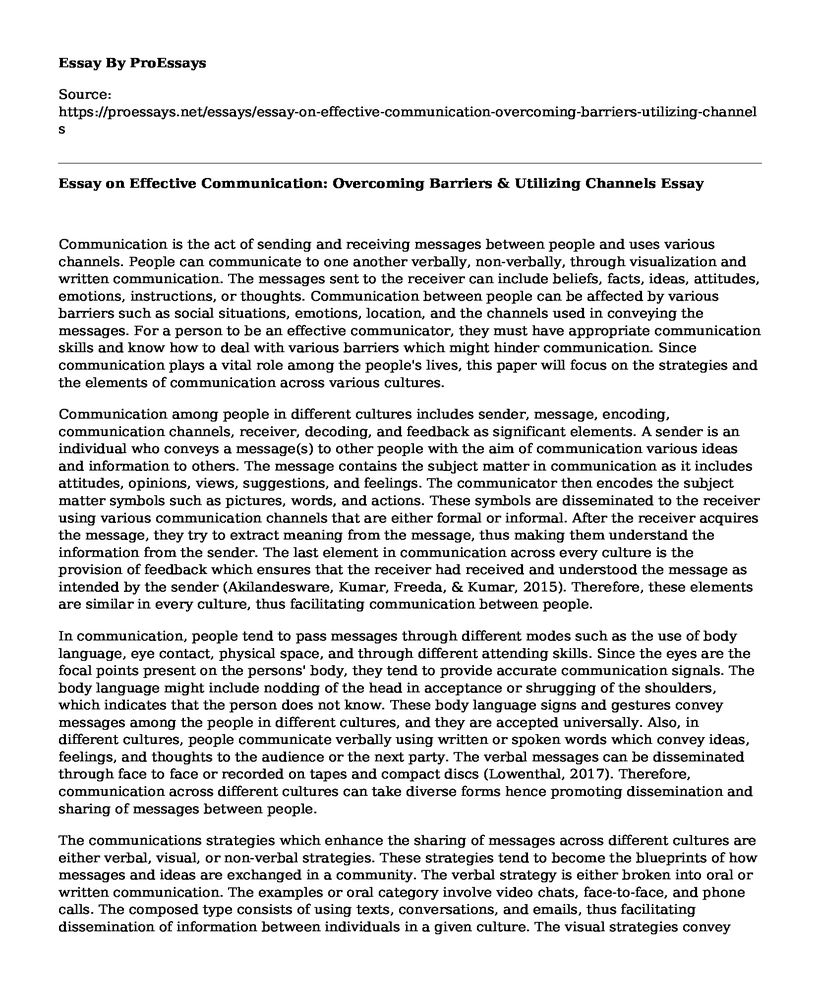Communication is the act of sending and receiving messages between people and uses various channels. People can communicate to one another verbally, non-verbally, through visualization and written communication. The messages sent to the receiver can include beliefs, facts, ideas, attitudes, emotions, instructions, or thoughts. Communication between people can be affected by various barriers such as social situations, emotions, location, and the channels used in conveying the messages. For a person to be an effective communicator, they must have appropriate communication skills and know how to deal with various barriers which might hinder communication. Since communication plays a vital role among the people's lives, this paper will focus on the strategies and the elements of communication across various cultures.
Communication among people in different cultures includes sender, message, encoding, communication channels, receiver, decoding, and feedback as significant elements. A sender is an individual who conveys a message(s) to other people with the aim of communication various ideas and information to others. The message contains the subject matter in communication as it includes attitudes, opinions, views, suggestions, and feelings. The communicator then encodes the subject matter symbols such as pictures, words, and actions. These symbols are disseminated to the receiver using various communication channels that are either formal or informal. After the receiver acquires the message, they try to extract meaning from the message, thus making them understand the information from the sender. The last element in communication across every culture is the provision of feedback which ensures that the receiver had received and understood the message as intended by the sender (Akilandesware, Kumar, Freeda, & Kumar, 2015). Therefore, these elements are similar in every culture, thus facilitating communication between people.
In communication, people tend to pass messages through different modes such as the use of body language, eye contact, physical space, and through different attending skills. Since the eyes are the focal points present on the persons' body, they tend to provide accurate communication signals. The body language might include nodding of the head in acceptance or shrugging of the shoulders, which indicates that the person does not know. These body language signs and gestures convey messages among the people in different cultures, and they are accepted universally. Also, in different cultures, people communicate verbally using written or spoken words which convey ideas, feelings, and thoughts to the audience or the next party. The verbal messages can be disseminated through face to face or recorded on tapes and compact discs (Lowenthal, 2017). Therefore, communication across different cultures can take diverse forms hence promoting dissemination and sharing of messages between people.
The communications strategies which enhance the sharing of messages across different cultures are either verbal, visual, or non-verbal strategies. These strategies tend to become the blueprints of how messages and ideas are exchanged in a community. The verbal strategy is either broken into oral or written communication. The examples or oral category involve video chats, face-to-face, and phone calls. The composed type consists of using texts, conversations, and emails, thus facilitating dissemination of information between individuals in a given culture. The visual strategies convey messages through the use of webpages, signs, and illustrations while the non-verbal strategies use mostly the visual cues like the tones of the communicator, facial expression and the body languages (Jones, 2017). Therefore, these strategies help to convey messages among various cultures, and people utilize them to communicate and give feedback to others.
Communication has proved to be vital across different cultures as people tend to send, receive, and provide feedback to others. Communication might be broken or altered by barriers, thus making it not to become efficient. A conversation which follows all the seven elements ends up being effective since the messages reach the receiver and they provide their feedback to the sender - the strategies which are used across different culture help in disseminating appropriate information to the public. Therefore, communication can be improved by observing different approach and the elements used in conveying messages.
References
Akilandesware, V., Kumar, A. D., Freeda, A. P., & Kumar, H. N. (2015). Elements of effective communication. New Media and Mass Communication, 37, 43-46. Retrieved from http://rdmodernresearch.org/wp-content/uploads/2015/09/20.pdf
Jones, P., (2017). Communicating strategy. Gower. Retrieved from https://www.unicef.org/cbsc/files/Writing_a_Comm_Strategy_for_Dev_Progs.pdf
Lowenthal, L., (2017). Literature and the Image of Man: Volume 2, Communication in Society. Routledge. Retrieved from http://nursing.uomosul.edu.iq/files/pages/page_6544106.pdf
Cite this page
Essay on Effective Communication: Overcoming Barriers & Utilizing Channels. (2023, Jan 23). Retrieved from https://proessays.net/essays/essay-on-effective-communication-overcoming-barriers-utilizing-channels
If you are the original author of this essay and no longer wish to have it published on the ProEssays website, please click below to request its removal:
- Multidimensional Theory of Gender Inequality Essay Example
- An Adult Child Who Grew up Without a Father - Research Paper
- Essay on Gender and Societal Behavior: Morals, Values, Roles
- Essay on Second-Parent Adoption: Securing the Future of Same-Sex Couple's Kids
- Paper Example on Integrating DESC & CR Models for Civility in Organizations
- Explore Sentinel City: Population and Income Analysis of Four Neighborhoods - Free Paper
- Free Paper Sample on IPV: A Global Public Health Concern







